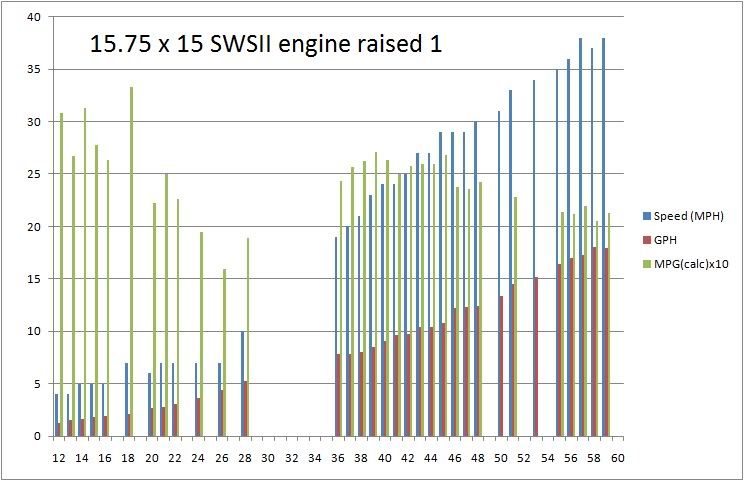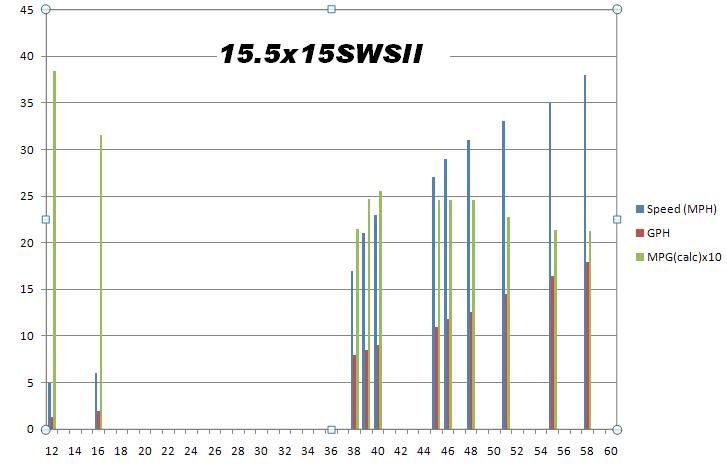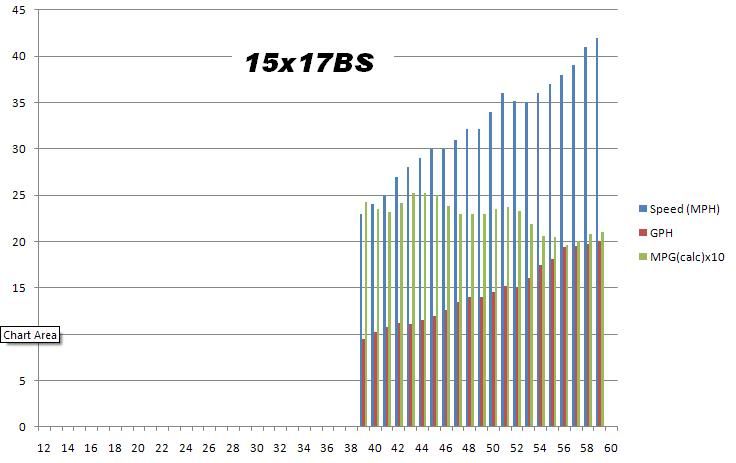Here's a new chart of the performance on my 2120 with F225 spinning the 15.75x15 Yamaha Saltwater Series II after raising the motor up 1 bolt hole from the factory location.
Every possible measure of goodness was improved: I could get on plane at lower RPM, less porpoising and better fuel economy at every speed (by almost 10% better mpg at optimal cruising rate). Another surprising benefit I didn't expect was that the prop seemed to hold its grip even better at the raised height. I was concerned about blowing out and ventilating more easily with the motor up higher, but I could actually run the trim out just as much or maybe even more with no problems.
Ran her a couple miles offshore through some chop in both head and following seas. Did a few tight turns at not slow speeds -- no problems at all.

Here's the previous run using same prop at the original motor height. Unfortunately, I didn't take a lot of data points that day, but you can see at 3800-4000rpm I was just barely able to hit 2.5mpg. Also at the 4600-4800 range I'm now hitting 2.6mpg at the raised height where you can see I was only about 2.4mpg at the original height. Most of my cruising mileage in the most used RPM ranges read 2.4mpg with a good trim on a following sea giving me maybe 2.5-2.6mpg.
At 1 bolt hole higher, now I'm reading solid 2.6's with 2.8-2.9 on a following sea, something I never saw before.
Also, the new chart has data points now down to 3600RPM because unlike before, I can hold a steady plane
at that low of RPM.

Next is the original chart with the 15x17 Yamaha Black Steel prop at the factory motor height.
Much higher top speed was possible (about 44mph at WOT), but very difficult to stay on plane down at the 3800-4000RPM range and doing any less than about 24-25mph (which was brutal traveling that fast through the kind of choppy swell and wind waves we usually have offshore here)

Every possible measure of goodness was improved: I could get on plane at lower RPM, less porpoising and better fuel economy at every speed (by almost 10% better mpg at optimal cruising rate). Another surprising benefit I didn't expect was that the prop seemed to hold its grip even better at the raised height. I was concerned about blowing out and ventilating more easily with the motor up higher, but I could actually run the trim out just as much or maybe even more with no problems.
Ran her a couple miles offshore through some chop in both head and following seas. Did a few tight turns at not slow speeds -- no problems at all.

Here's the previous run using same prop at the original motor height. Unfortunately, I didn't take a lot of data points that day, but you can see at 3800-4000rpm I was just barely able to hit 2.5mpg. Also at the 4600-4800 range I'm now hitting 2.6mpg at the raised height where you can see I was only about 2.4mpg at the original height. Most of my cruising mileage in the most used RPM ranges read 2.4mpg with a good trim on a following sea giving me maybe 2.5-2.6mpg.
At 1 bolt hole higher, now I'm reading solid 2.6's with 2.8-2.9 on a following sea, something I never saw before.
Also, the new chart has data points now down to 3600RPM because unlike before, I can hold a steady plane
at that low of RPM.

Next is the original chart with the 15x17 Yamaha Black Steel prop at the factory motor height.
Much higher top speed was possible (about 44mph at WOT), but very difficult to stay on plane down at the 3800-4000RPM range and doing any less than about 24-25mph (which was brutal traveling that fast through the kind of choppy swell and wind waves we usually have offshore here)





